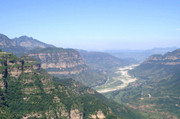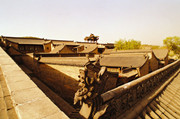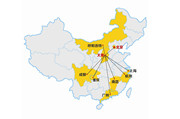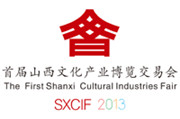At home with change
By Sun Yuanqing ( China Daily )
Updated: 2013-11-10
An innovative project fusing the private, government and NGO sectors aims to go beyond restoring ancient Pingyao's major structures to include its residences, as they contain the town's most important heritage - its people. Sun Yuanqing reports.
Ji Hongfu was born with a priceless asset - his house. It has since become the 39-year-old's greatest liability.
Twenty-three generations of Ji's family have dwelled in the 664-year-old courtyard in Shanxi province's ancient Pingyao town. The structure survived the family fortune's ups and downs over the centuries. A history of clan prosperity is evident in the spacious layout, exquisitely sculpted windows and family motto inscribed on the gate.
But this past glory is also faded glory. While the exterior remains resplendent, the interior is crumbling at an exponential pace, Ji says.
The erosion-resistant pillars are eroding. The roof leaks. The walls are disintegrating.
"It's not easy to live in," Ji says. "But we don't have the money or expertise to fix it."
Ji is among hundreds of residents who aspire to maintain their properties in the UNESCO World Heritage site that private investment has propelled to rank among the country's top tourist destinations.
While Pingyao's major structures have largely been restored and protected, private investment hasn't helped residences like Ji's.
That's where a new architectural heritage-protection model unlike any in China comes in.
Its backbone is the partnership of the private sector, government and nonprofit Global Heritage Fund.
"Pingyao's real gems are its ancient residences," the city's urban and rural planning bureau director Ji Taiping explains.
"But they've been essentially neglected. We'll probably lose them forever if we don't act now."
Ji Taiping believes such residence's disappearance would be tragic. He points out Pingyao's future will be determined by what its ancient houses contain - its people.
Pingyao was settled in the Western Zhou Dynasty (c.11th century- 771 BC) and expanded to its present scale in the Ming Dynasty (1368-1644). It became the country's financial center during the Qing Dynasty (1644-1911), when it housed 20 financial institutions - more than half the nation's.
It was the headquarter of the country's first bank, Rishengchang, which controlled about half the national silver trade in its golden age.
Pingyao's architectural legacy was largely built upon this commercial prosperity.
The city remains among the world's best-preserved. The city wall is the crown of its imperial history, but its jewels are the more than 3,700 ancient houses studding the 2.25 square kilometers the bulwark sheaths.
However, the tourist throngs who come to marvel at the architectural treasure trove have inadvertently brought tarnish to the private homes as some locals renovate their houses into larger hostels to make money.
Others simply leave their houses to decay because ancient structures' renovations cost about twice as much as modern concrete buildings'.
That's where the new model came in last year. It's devised to encourage individual families to invest while the government and World Heritage Fund subsidize renovations' finance and technical management.
The deal is available to any private owner of a house with historical value, intact structure and clear ownership. Houses renovated through the project can't be used for commercial purposes.
"They were built for living in and will be renovated for the same purpose," Ji says. "Life in Pingyao will go on and the city will have a future only if people are willing to stay."
Liu Chuanjing has lived in his courtyard since 1943. The tiled roof leaked, the walls were cracked and the pine gate was rotting.
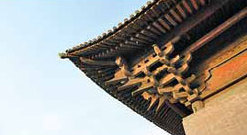
"I have always wanted to restore it properly but never got around to it," the 72-year-old retired teacher says. "When the project started, I knew it was time."
An expert panel inspected Liu's abode. They snapped photos and revised a detailed restoration plan Liu had to approve.
Liu contracted labor and materials from a renovation company certified by the panel.
The old tiles were removed, cleaned and spackled with red clay and hay - a traditional mix to prevent leaks. They were then replaced on the original structure.
Broken bricks had to be replaced with intact ones from other houses, since the types of bricks from which Pingyao is built are no longer produced.
The pine gate was refurbished.
A supervisor checks Liu's home daily to ensure all materials and methods are authentically ancient. Each supervisor in the project visits more than 10 homes a day.
Liu says about 60,000 yuan ($9,800) of the 155,000 yuan restoration is subsidized in accordance with his house's historical value and damage.
Pingyao has so far invested more than 20 million yuan in the project, two-thirds of which is subsidized by the government and the Global Heritage Fund, Ji Taiping says.
A total of 190 households applied, and 28 have been restored. Renovations are ongoing at another 14.
The project's consequences are expected to expand beyond Pingyao.
"This project will provide insight for what we will be doing next: the idea of getting the private sector, the community and the government work together," UNESCO Beijing Office director Abhimanyu Singh said, after he visited a private residence under renovation in mid-August.
"It is a small beginning. But it is important because what happens here gets reported back to the World Heritage Committee. The experience gets shared and can be built upon in other countries."
But even renovations perhaps won't stop Pingyao's outflow of young people. The population increasingly belongs to Liu's generation.
"What happens when this generation is no longer there?" Singh says.
While Singh expects tourism to be the major source of revenue to protect and maintain Pingyao in the long term, the town is also looking for new money-spinners.
The government built a 130 million yuan industrial park to develop hand-polished lacquer ware, a millennium-old local handicraft listed as a national intangible cultural heritage.
A modern international art center was built in a former textile mill.
The hottest new attraction is the Another Glance at Pingyao performance that infuses the town's history and culture into a tragic epic.
Ji Hongfu believes a renovation will make his house more livable for his family.
His greatest concern is his courtyard was built in the Yuan Dynasty (1271-1368), while most hail from the Ming and Qing eras.
So, he worries the local craftsman might not be familiar with Yuan-style building methods.
"I've been watching their work," he says. "The houses they renovated last year are more authentic than those they did the year before. This year is even better. I believe there is a future for our house. It's a gift from our ancestors - one we'll pass on.
Contact the writers at sunyuanqing@chinadaily.com.cn and sunruisheng@chinadaily.com.cn.
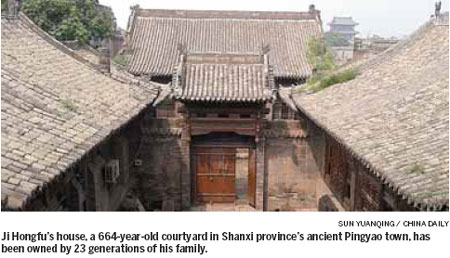
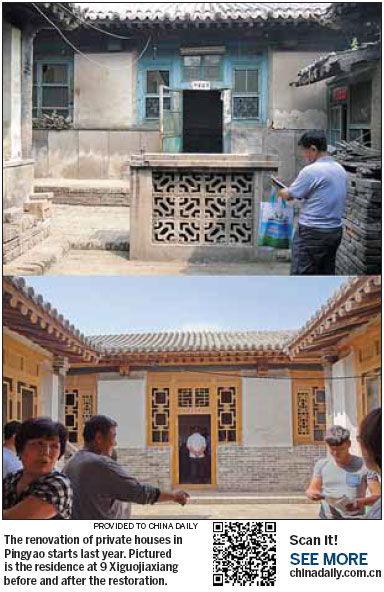
(China Daily 11/10/2013 page1)
